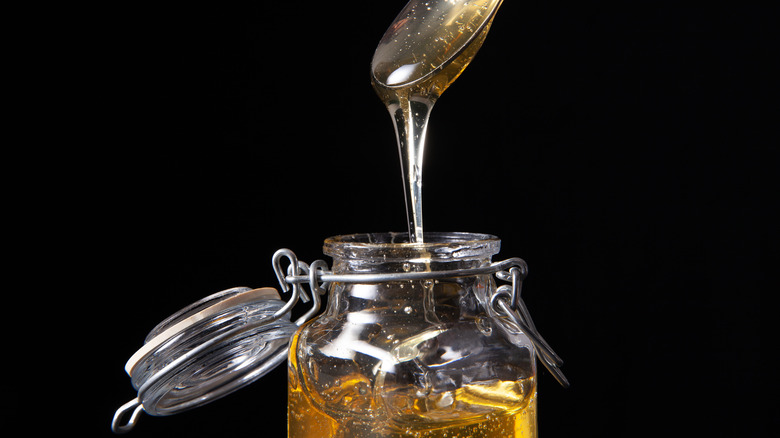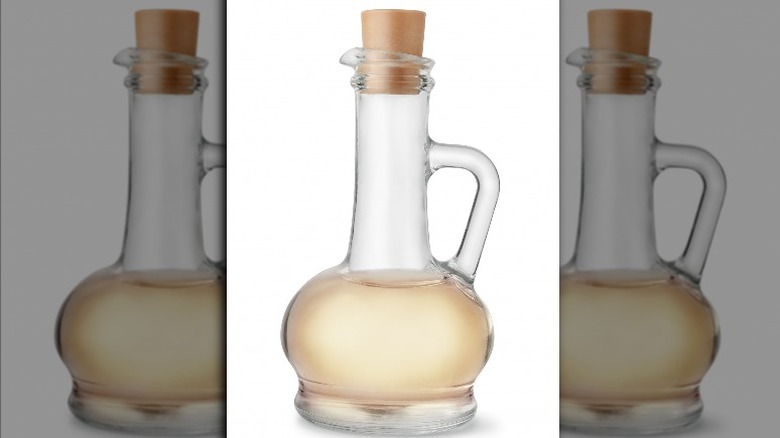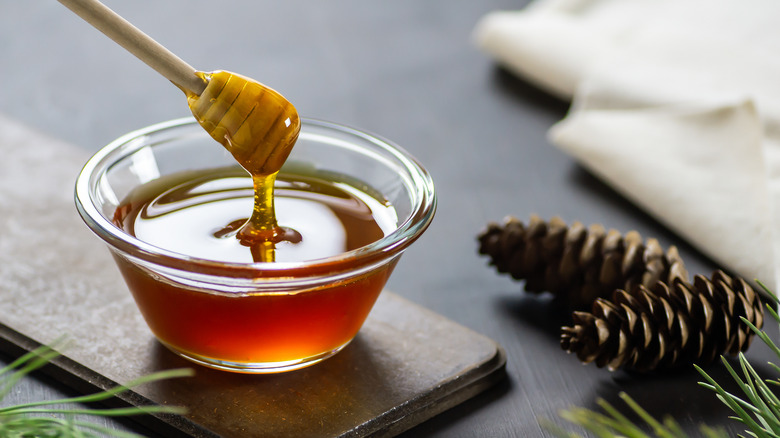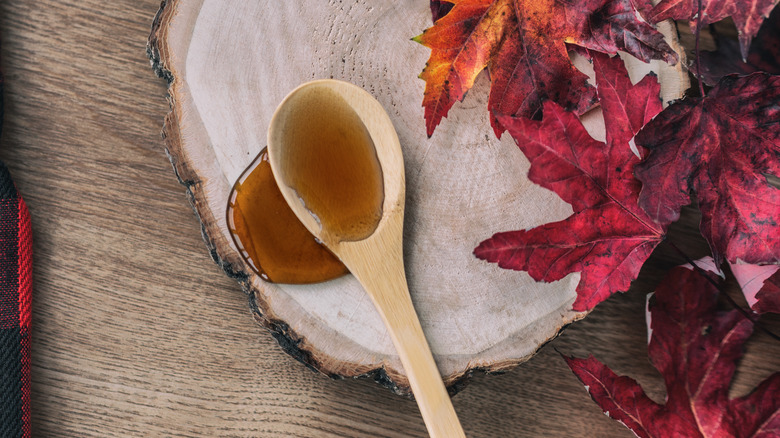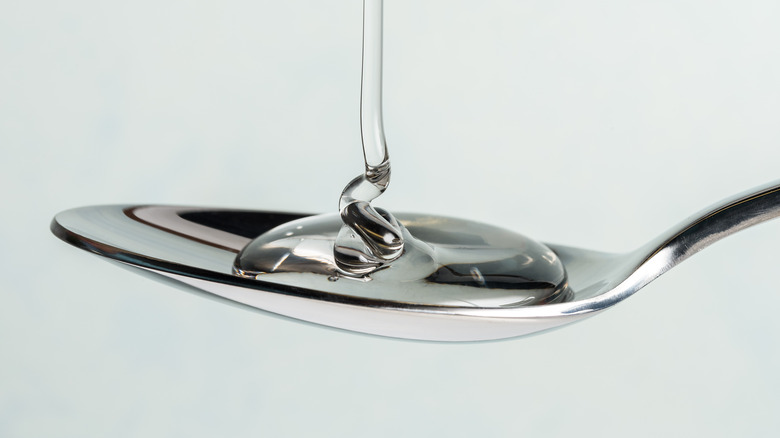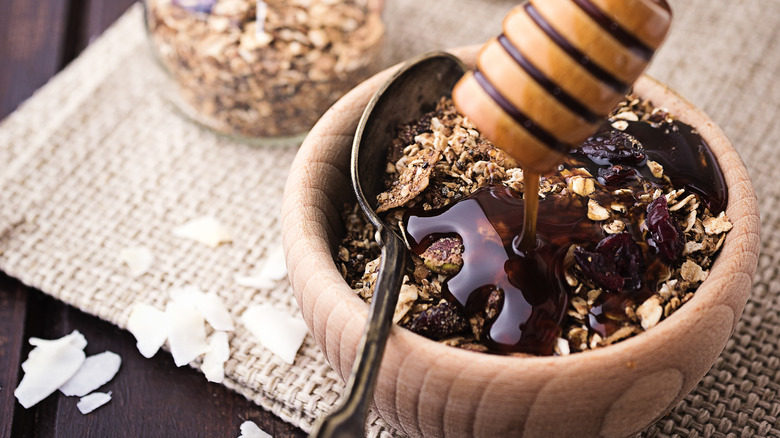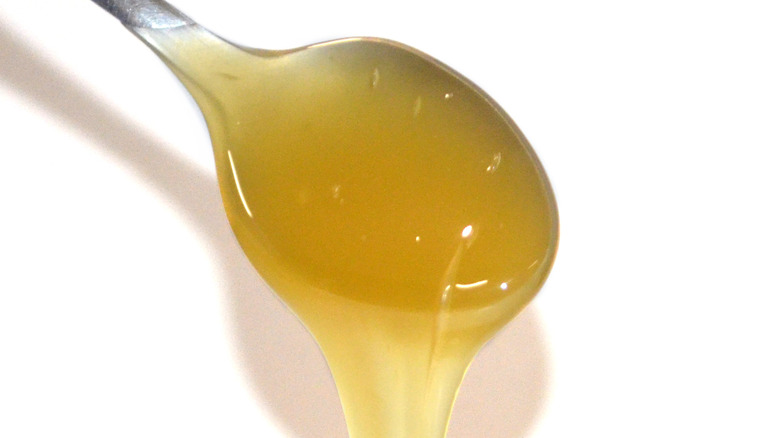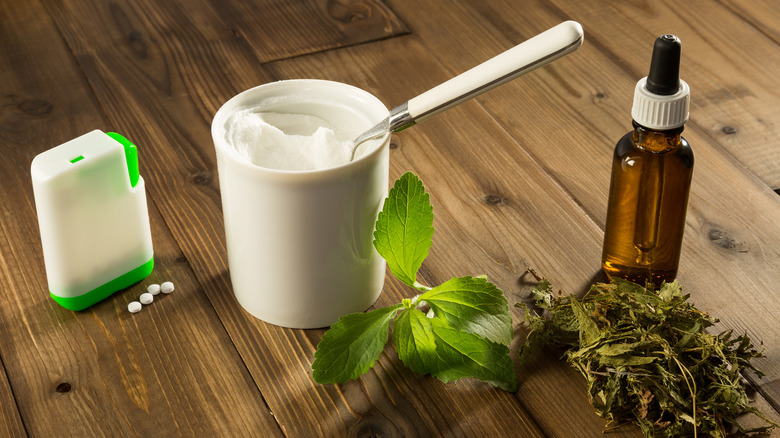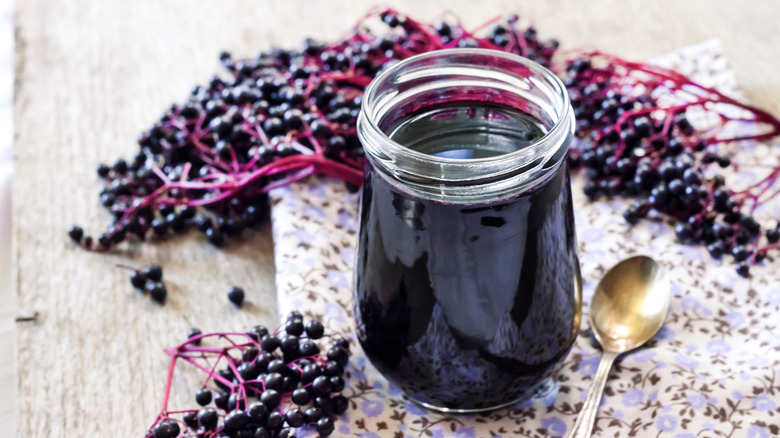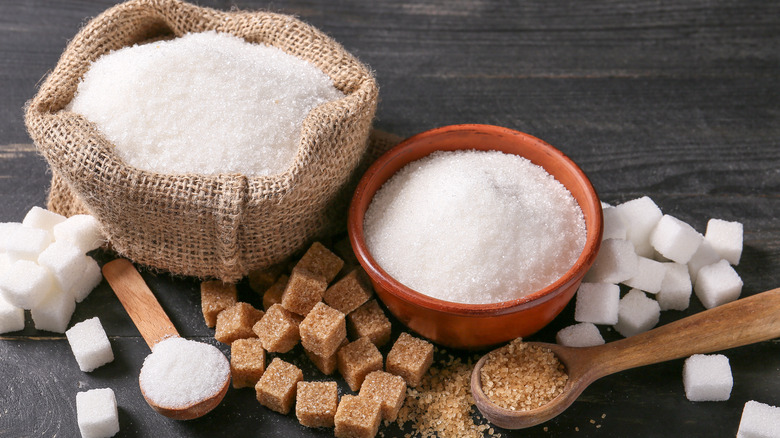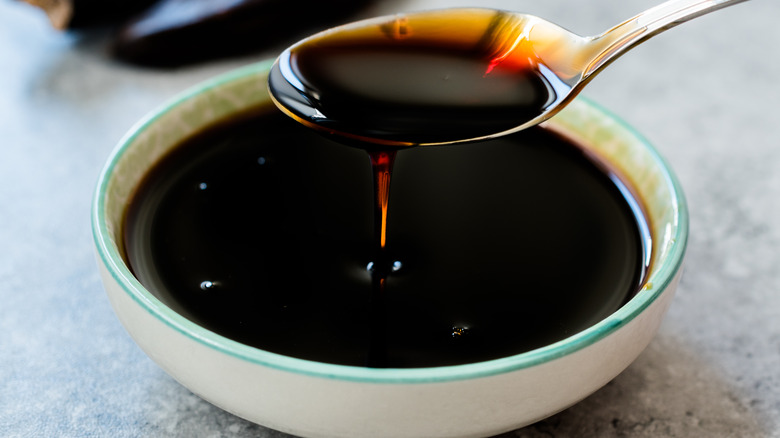10 Best Substitutes For Agave Nectar
We may receive a commission on purchases made from links.
People have long sought alternatives to sugar, and for good reason. Eating too much sugar can lead to heart disease, diabetes, and obesity. Yet almost all of us love the taste of sweet things. Why shouldn't we? Refined sugar activates the pleasure centers of our brain, releasing dopamine, which makes us feel great, if only temporarily (via MultiCare).
Agave nectar is one of those sweeteners people have turned to as a healthier substitute for sugar. It's often called for in cocktails or other cold drinks because as a liquid, it dissolves quickly. Agave nectar is sweeter than sugar, and has a faint honey flavor. Conjuring images of sweet droplets from lush plants in a warm vacation destination, agave nectar sounds so pure and delicious, doesn't it? We hate to burst your bubble, but agave might actually be worse for your health than real sugar.
According to Healthline, agave has been used by people in Latin America for more than 200 years for medicinal purposes; they have traditionally boiled its sap to create a sweetener called "miel de agave." However, food manufacturers today make agave "nectar" in a way that is similar to other artificial sweeteners: subjecting the agave sugars to heat and enzymes, resulting in a highly refined and unhealthy fructose product, which the liver is forced to break down and is easily converted into fat (via Epicurious).
Whether you need some for a recipe and don't have any or simply want to explore different sweeteners, consider these alternatives to agave nectar.
1. Simple Syrup
For cocktails and drinks that call for agave nectar, you can substitute simple syrup, the default sweetener of bartenders everywhere. Simple syrup is as easy to make as it sounds. It requires just two ingredients: water and granulated sugar. According to Liquor.com, you simply combine a half cup of sugar and a half cup of water in a sauce pan and heat it over medium, stirring until the sugar is dissolved. Let your simple syrup cool before using it or refrigerating.
Simple syrup should stay fresh in your refrigerator for a month, ready for your next iced coffee or daiquiri or whatever you intended to use agave nectar for. What's more, simple syrup gives you flavor options that agave nectar doesn't. As Liquor.com notes, countless additions can be added to customize your simple syrup. Add mint leaves, ginger, vanilla, basil, or anything your heart desires.
You will need about 50% more simple syrup if you are substituting it for agave nectar, according to The Spruce Eats.
2. Honey
Who doesn't love the taste of honey? This natural option has the same number of calories (64 per tablespoon, per Healthline) as agave nectar, but without all the processing and fructose. According to the Food Network, agave nectar's dark amber color might make you think its flavor profile is similar to honey, but, while somewhat similar, agave nectar is actually more neutral than its bee-produced counterpart.
Honey is healthier than agave nectar, with health benefits such as providing sore throat relief and immune support. As Food Network explains, honey also contains minerals such as iron, copper, niacin, riboflavin, potassium, and zinc. According to Healthline, high-quality honey is also rich in antioxidants, including organic acids and phenolic compounds such as flavonoids. Honey also has more glucose than it does fructose, which Healthline says gives it a "massive leg up" over fructose-heavy agave.
According to Vegetarian Times, you can substitute honey for agave nectar in equal measure.
3. Maple syrup
Organic Authority points out that like agave nectar, maple syrup has a lower glycemic index than sugar, making it a good choice for those watching their blood sugar. What's more, maple syrup has only 50 calories per tablespoon versus agave nectar's or honey's 63 calories (per Michigan State University). Maple syrup is derived from the tree sap of the sugar maple. Once tapped and collected, the sap is boiled to remove the water. The longer the sap is boiled, the darker and more flavorful the syrup.
There are four classifications of maple syrup: Grade A Light Amber, Grade A Medium Amber, Grade A Dark Amber, and Grade B. Because agave nectar has a neutral flavor, Grade A Light Amber will deliver the closest flavor to agave. According to Organic Authority, maple syrup also has nutritional benefits, with over 50 anti-inflammatory compounds.
Like honey, pure maple syrup (not pancake syrup) can be substituted for agave nectar, measure for measure, according to Gourmet Sleuth.
4. Corn Syrup
Corn syrup is made from corn starch, and its sweetness is neutral, making its flavor profile similar to that of agave nectar. Corn syrup is often used in candy, icings, ice creams, cooking, cake, and other baked goods. According to Tarla Dalai, corn syrup's advantage as a sweetener is that it doesn't crystallize.
The Kitchn advises that when shopping, you should read labels carefully, as some products labeled "corn syrup" actually have the less-healthy high-fructose corn syrup as an ingredient. (High-fructose corn syrup has had some of its glucose converted to fructose, while regular corn syrup is 100% glucose.) There are two types of corn syrup, light and dark. Dark corn syrup has a molasses flavor, whereas the light variety is more neutral, making it the better substitute for agave nectar.
According to Substitute Cooking, an equal amount of corn syrup can be swapped for agave nectar.
5. Coconut Nectar
Coconut nectar is a great substitute for any application that calls for agave nectar. In fact, in 2017, Epicurious called coconut nectar "the new agave." Like agave nectar, coconut nectar has a lower glycemic index than sugar: 35, which is about half that of granulated sugar. An advantage of coconut nectar is that it is less refined than agave nectar. According to Epicurious, this sweetener (made from the coconut tree's flowers) is heated only enough to thicken it and create a syrupy consistency, but not so hot as to create fructose, as happens in agave processing.
The sweetness of coconut nectar is mild and similar to agave, although Epicurious notes the flavor varies significantly from brand to brand, ranging from floral to earthy. As you would with any liquid sweetener, you can use coconut nectar in baking. In recipes that call for a large amount of sweetener, however, coconut nectar is not recommended as the flavor can be slightly bitter in large quantities.
You'll need about 25% more coconut nectar when substituting it for agave nectar.
6. Brown Rice Syrup
A sweetener called brown rice syrup is another good alternative to agave nectar. According to Spoon University, brown rice syrup is made by fermenting brown rice, which breaks down the starches in the rice. The substance is then reduced to a syrupy consistency.
Brown rice syrup is essentially pure glucose, with a higher glycemic index than agave nectar, table sugar, and basically any other sweetener. It can be used in any recipe that calls for agave nectar. Brown rice syrup can be used in baking, and it's useful for sweetening beverages. Substitute Cooking says brown rice syrup is less sweet than agave nectar, so you will need to adjust your recipes accordingly. You can find brown rice syrup in most grocery or organic food stores and on Amazon.
You should use about 1 ¼ cups of brown rice syrup for ¾ cups of agave nectar called for in your recipe.
7. Stevia
According to Spiceography, in its popular powdered form, stevia is often used as a substitute for granulated sugar in baking or for use as table sugar. This sweetener can also be used as a substitute for agave nectar. Stevia is derived from the Stevia rebaudiana plant, which is native to South America and Asia, according to The Globe and Mail. It has no calories, but it tastes 10 to 15 times sweeter than sugar. According to Livestrong, the body does not metabolize stevia, so it does not raise blood sugar levels. Its sweetness (which has a slightly bitter aftertaste) comes from compounds in the plant called steviol glycosides.
For best results, use roughly the same amount of stevia as you would agave, but Spiceography notes that if your stevia is a powder it could cause inconsistencies if a recipe requires large amounts of sweetener. Liquid stevia is available in most supermarkets and is a useful agave nectar substitute in drinks and cocktails. We also found it at Trader Joe's, and Amazon sells several brands of stevia as well.
8. Fruit Syrup
Not just for pancakes or waffles, a fruit-based syrup can also work in place of agave nectar. Definitely the most wholesome alternative on this list, the website Substitute Cooking suggests simply mixing up a batch of fruits plus a little water in your blender for an all-natural, unprocessed sweetener.
This "syrup" (actually a fruit puree) can vary in sweetness depending on the fruits you choose. The Spruce Eats creates a more classic fruit syrup, using fresh or frozen berries, water, and some granulated sugar, cooking it down and mashing the berries as it reduces to a syrupy consistency. The syrup can be strained for a thinner consistency or placed in a food processor to thicken it. We think fruit syrups are a great sweetener for your favorite summer cocktails or punches. Of course, a variety of fruit syrups can also be found in stores and online, such as Liber & Co.'s Exotic Passionfruit Syrup.
9. Granulated Sugar
According to the Food Network, one tablespoon of agave nectar has about 60 calories compared to about 45 and 60 calories in the same amount of granulated sugar and honey, respectively. If a baking recipe calls for agave nectar, you can substitute granulated sugar, but you will need to increase other liquids in your recipe to make up for the lost liquid from the omitted agave.
Agave nectar is the better choice for those watching their blood sugar, given that its glycemic index is five times lower than that of sugar (via Eating Well). However, regular cane sugar is the less processed choice, according to Healthline, as treating the agave plant with heat and enzymes destroys any potentially beneficial effects of the agave plant, delivering only a "a highly refined, unhealthy syrup." Which is better? It seems like a classic case of "pick your poison" situation for consumers concerned about their health.
Sugar and agave nectar are easily interchanged. Agave, however, is about one-and-a-half times sweeter than sugar, so adjust your recipe accordingly.
10. Molasses
With a flavor that's been described as sweet, warm, and even somewhat smoky, you might find that molasses can fill in for agave nectar in your next recipe calling for agave. According to Vegan Runner Eats, this syrupy liquid is a byproduct of the sugar cane or sugar beet refinement process. This process begins with the mashing of the sugar cane or sugar beets to extract their juice. This liquid is then boiled up to three times to produce various grades of molasses. At each step, according Vegan Runner Eats, the sugars are crystallized, removed, and sold as granulated sugar. The liquid left behind is molasses.
The first boiling produces light molasses or "cane syrup." If boiled a second time, the thicker, more intensely flavored syrup is called "dark molasses." A third boiling produces a more bitter product called "blackstrap molasses," which should be mixed with other sweeteners to counteract its bitterness. Blackstrap molasses has some beneficial nutrients, including iron, calcium, magnesium, selenium, and vitamin B6.
A recipe that calls for ¾ cup of agave nectar will require approximately ½ cup of molasses.
